Strain Field Evolution Analysis of Brittle Shale with Initial Fractures Based on DIC
Abstract
:1. Introduction
2. Uniaxial Compression Experiment on Shale
2.1. Shale Specimen Preparation
2.2. Prefabricated Holes and Cracks
2.3. Experimental Steps
2.3.1. CT Scanning of Internal Image of Shale Specimens
2.3.2. Spraying Speckles
2.3.3. Uniaxial Compression Experiment
- (1)
- Installing of Shale Specimens
- (2)
- Setting Up a Non-Contact Whole-Strain Measurement System (ARAMIS-4M)
- (3)
- Calibration of the Non-Contact Whole-Strain Measurement System
- (4)
- Real-Time Image Acquisition of Shale Specimen Compression Process
- (5)
- Outputting of Experimental Data
3. Experimental Results and Analysis
4. Summary and Prospect
Author Contributions
Funding
Institutional Review Board Statement
Informed Consent Statement
Data Availability Statement
Conflicts of Interest
References
- Wen, M.L. Experimental and Numerical Simulation Study on Compressive Fracture Process of Rock-like Materials with Built-in Three-Dimensional Cracks. Master’s Thesis, Chongqing University, Chongqing, China, 2020. [Google Scholar]
- Zhang, Y.; Zou, Y.; Zhang, Y.; Wang, L.; Liu, D.; Sun, J.; Ge, H.; Zhou, D. Experimental Study on Characteristics and Mechanisms of Matrix Pressure Transmission Near the Fracture Surface During Post-Fracturing Shut-In in Tight Oil Reservoirs. J. Pet. Sci. Eng. 2022, 219, 111133. [Google Scholar] [CrossRef]
- Cheng, W.; Sun, J.; Yin, D.; Jiang, G. Research progress on wellbore instability mechanism and prediction model of deep mud shale. Drill. Eng. 2021, 48, 21–28. [Google Scholar]
- Hoek, E.; Bieniawski, Z.T. Brittle fracture propagation in rock under compression. Int. J. Fract. 1965, 1, 137–155. [Google Scholar] [CrossRef]
- Lajtai, E.Z. Brittle fracture in compression. Int. J. Fract. 1974, 10, 525–536. [Google Scholar] [CrossRef]
- Lin, P.; Wong, R.H.C.; Wang, R.-K.; Zhou, W.-Y. Crack growth mechanism and failure behavior of specimen containing single flaw with different angles. Chin. J. Rock Mech. Eng. 2005, 24, 5652–5657. [Google Scholar]
- Yang, S. Study on strength failure and crack propagation characteristics of sandstone with three intermittent fractures. Rock Soil Mech. 2013, 1, 31–39. [Google Scholar]
- Xu, J.; Li, Z. Crack Propagation and Coalescence of Step-Path Failure in Rocks. Rock Mech. Rock Eng. 2019, 52, 965–979. [Google Scholar] [CrossRef]
- Liu, X.; Yin, Z.; Wang, Y. Mechanical properties and failure mode of rock mass containing V-type intersecting fissures(Article). Meitan Xuebao/J. China Coal Soc. 2020, 45, 651–659. [Google Scholar]
- Dong, L.; Zhang, Y.; Sun, D.; Chen, Y.; Tang, Z. Stage characteristics of acoustic emission and identification of unstable crack state for granite fracture. Chin. J. Rock Mech. Eng. 2022, 41, 120–131. [Google Scholar]
- Li, T.C.; Lv, H.B.; Wang, H. CT real-time scanning tests on double cracks propagation under uniaxial compression. Rock Soil Mech. 2010, 31, 9–14. [Google Scholar]
- Zhao, Y.; Huang, J.; Hou, J.; Wang, R. Experimental observation of rock meso-fracture and its implications for understanding seismic activity. Chin. J. Geophys. 1995, 5, 627–636. [Google Scholar]
- Chu, T.C.; Ranson, W.F.; Sutton, M.A. Applications of digital-image-correlation techniques to experimental mechanics. Exp. Mech. 1985, 25, 232–244. [Google Scholar] [CrossRef]
- Peters, W.H.; Ranson, W.F. Digital Imaging Techniques In Experimental Stress Analysis. Opt. Eng. 1982, 21, 213427. [Google Scholar] [CrossRef]
- Shi, Y.; Blaysat, B.; Chanal, H.; Grédiac, M. Designing Patterns for DIC with Poisson Image Editing. Exp. Mech. 2022, 62, 1093–1117. [Google Scholar] [CrossRef]
- Wang, C.; Wang, S.; Xie, L.; Liu, Y.; Deng, J.; He, W. Fatigue crack growth behavior of marine steel under variable amplitude loading-combining DIC technique and SEM observation. Int. J. Fatigue 2023, 170, 107508. [Google Scholar] [CrossRef]
- Abbassi, F.; Ahmad, F. Behavior analysis of concrete with recycled tire rubber as aggregate using 3D-digital image correlation. J. Clean. Prod. 2020, 274, 123074. [Google Scholar] [CrossRef]
- Mata-Falcón, J.; Haefliger, S.; Lee, M.; Galkovski, T.; Gehri, N. Combined application of distributed fibre optical and digital image correlation measurements to structural concrete experiments. Eng. Struct. 2020, 225, 111309. [Google Scholar] [CrossRef]
- Gehri, N.; Mata-Falcon, J.; Kaufmann, W. Refined extraction of crack characteristics in large-scale concrete experiments based on digital image correlation. Eng. Struct. 2022, 251, 113486. [Google Scholar] [CrossRef]
- Meng, S.; Jiao, C.; Ouyang, X.; Niu, Y.; Fu, J. Effect of steel fiber-volume fraction and distribution on flexural behavior of Ultra-high performance fiber reinforced concrete by digital image correlation technique. Constr. Build. Mater. 2022, 320, 126281. [Google Scholar] [CrossRef]
- Eichhorn, G.N.; Bowman, A.; Haigh, S.K.; Stanier, S. Low-cost digital image correlation and strain measurement for geotechnical applications. Strain 2020, 56, e12348. [Google Scholar] [CrossRef] [Green Version]
- Arza-García, M.; Núez-Temes, C.; Lorenzana, J.A.; Ortiz-Sanz, J.; Castro, A.; Portela-Barral, M.; Gil-Docampo, M.; Bastos, G. Evaluation of a low-cost approach to 2-D digital image correlation vs. a commercial stereo-DIC system in Brazilian testing of soil specimens. Arch. Civ. Mech. Eng. 2022, 22, 4. [Google Scholar] [CrossRef]
- Plé, O.; Tourabi, A.; Abuaisha, M.S. 3-Dimensional Digital Image Correlation for Strains Determination in Clayey Soil. Appl. Mech. Mater. 2013, 353–356, 463–466. [Google Scholar] [CrossRef]
- Wang, W.; Ye, Y.; Wang, Q.; Hu, N. Experimental Study on Anisotropy of Strength, Deformation and Damage Evolution of Contact Zone Composite Rock with DIC and AE Techniques. Rock Mech. Rock Eng. 2022, 55, 837–853. [Google Scholar] [CrossRef]
- Cheng, Y.; Song, Z.; Yang, T.; Han, J.; Wang, B.; Zhang, Z. Investigation on aging deformation and damage mechanics characteristics of layered hard sandstone based on digital image correlation (Dic) technology. SSRN Electron. J. 2022, 8–9. [Google Scholar] [CrossRef]
- Miao, S.; Pan, P.-Z.; Li, S.; Chen, J.; Konicek, P. Quantitative fracture analysis of hard rock containing double infilling flaws with a novel DIC-based method. Eng. Fract. Mech. 2021, 252, 107846. [Google Scholar] [CrossRef]
- Xu, J.; Song, X.Z.; Peng, S.J.; Chen, C.C.; Ran, X.M.; Yan, F.Z. Experimental study of generalized stress relaxation of rock based on 3D-DIC technology. Rock Soil Mech. 2021, 42, 27–38. [Google Scholar]
- Zhang, K.; Qi, F.F.; Chen, Y.L. Deformation and fracturing characteristics of fracture network model and influence of filling based on 3D printing and DIC technologies. Yantu Lixue/Rock Soil Mech. 2020, 41, 2555–2563. [Google Scholar]
- Song, Y.; Jiang, Y.; Ma, S.; Yang, X.B.; Zhao, T. Evolution of deformation fields and energy in whole process of rock failure. Yantu Lixue/Rock Soil Mech. 2012, 33, 1352–1356. [Google Scholar]
- Zhu, Q.; Li, D.; Li, X. Experimental study on failure and mechanical characteristics of marble containing a prefabricated elliptical hole. Chin. J. Rock Mech. Eng. 2019, 38, 2724–2733. [Google Scholar]
- Vanderesse, N.; Richter, A.; Nuno, N.; Bocher, P. Measurement of deformation heterogeneities in additive manufactured lattice materials by digital image correlation: Strain maps analysis and reliability assessment. J. Mech. Behav. Biomed. Mater. 2018, 86, 397–408. [Google Scholar] [CrossRef]
- Alhakim, G.; Núñez-Temes, C.; Ortiz-Sanz, J.; Arza-García, M.; Jaber, L.; Gil-Docampo, M.L. Experimental application and accuracy assessment of 2D-DIC in meso-direct-shear test of sandy soil. Measurement 2023, 211, 112645. [Google Scholar] [CrossRef]
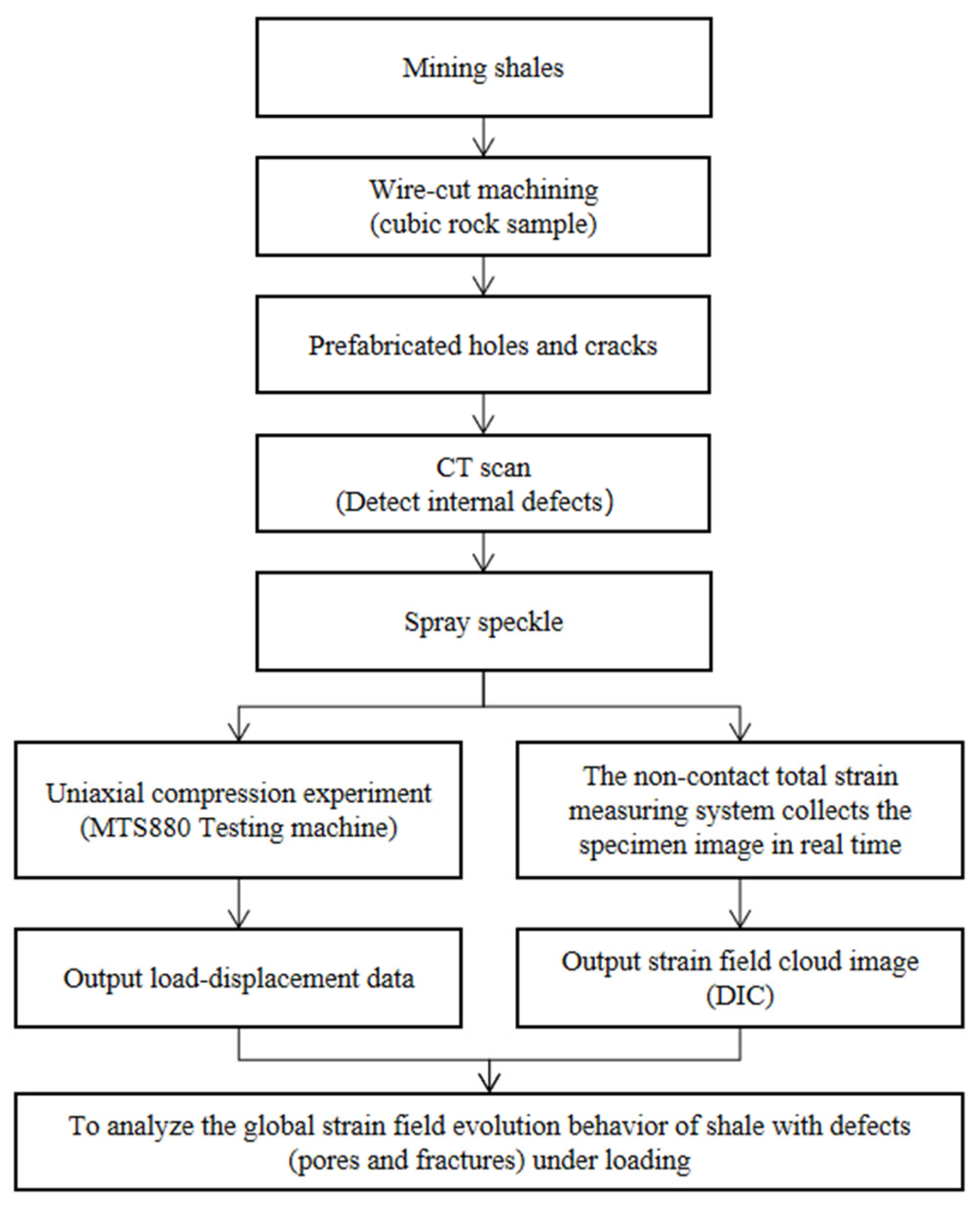
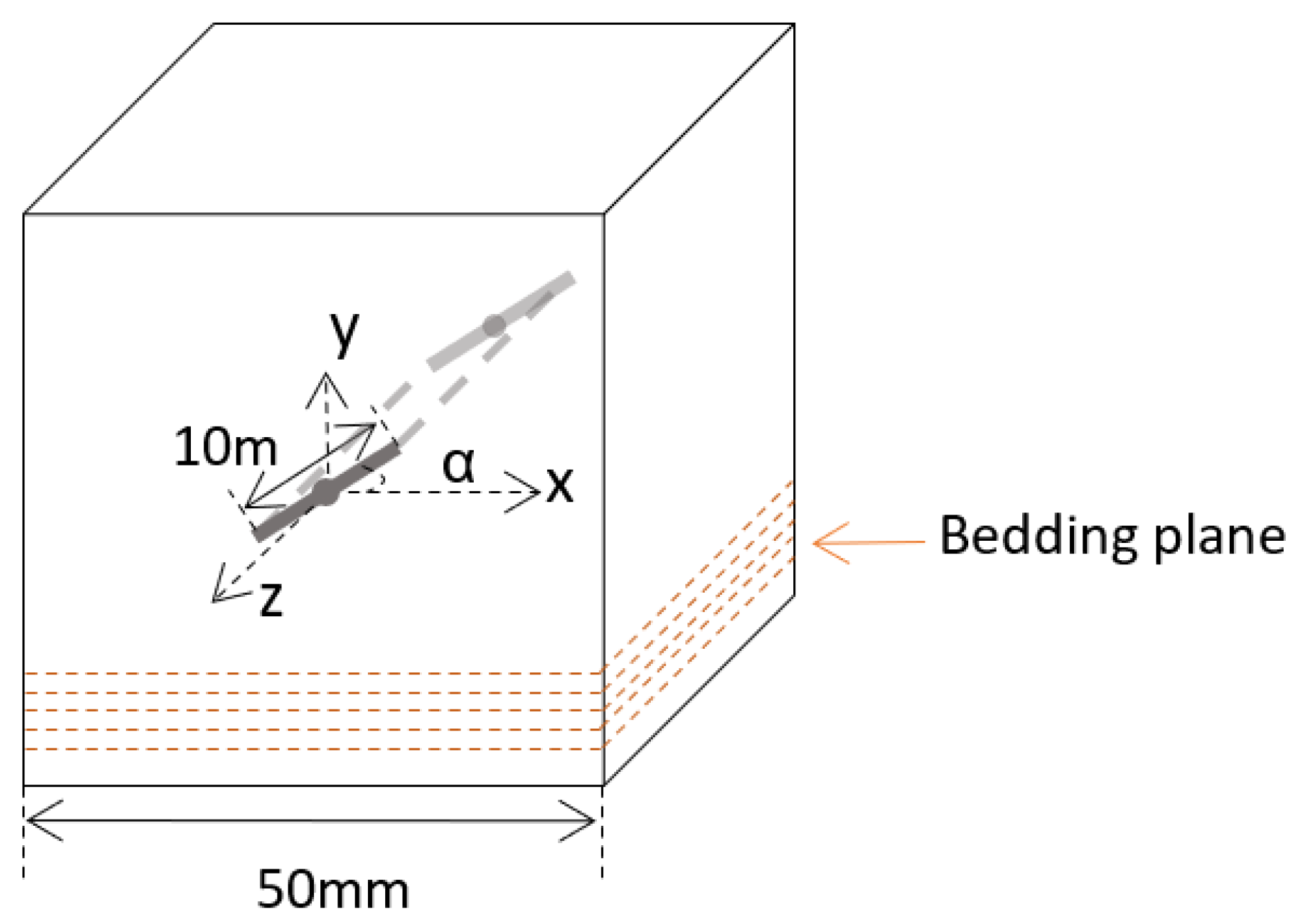

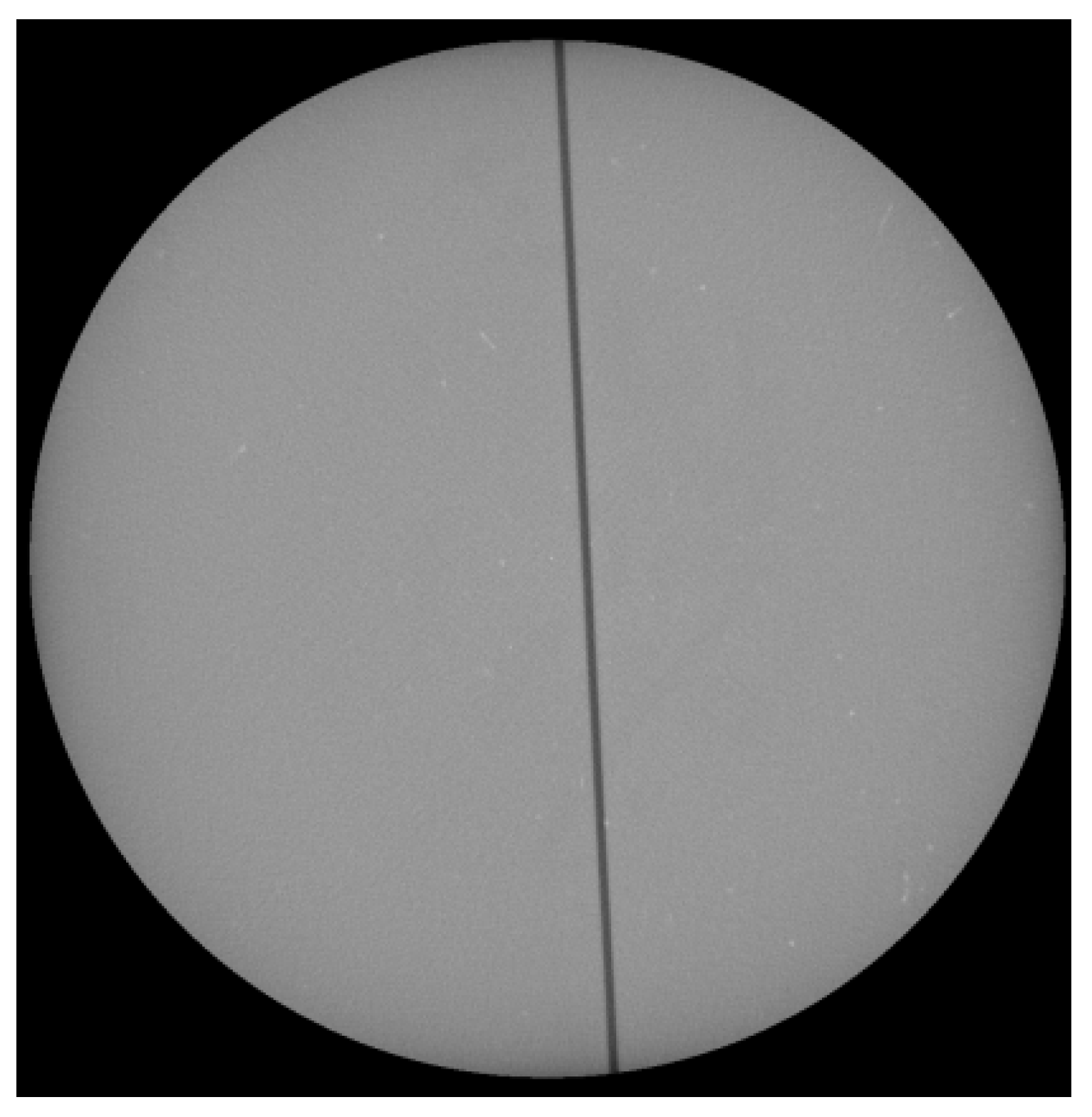
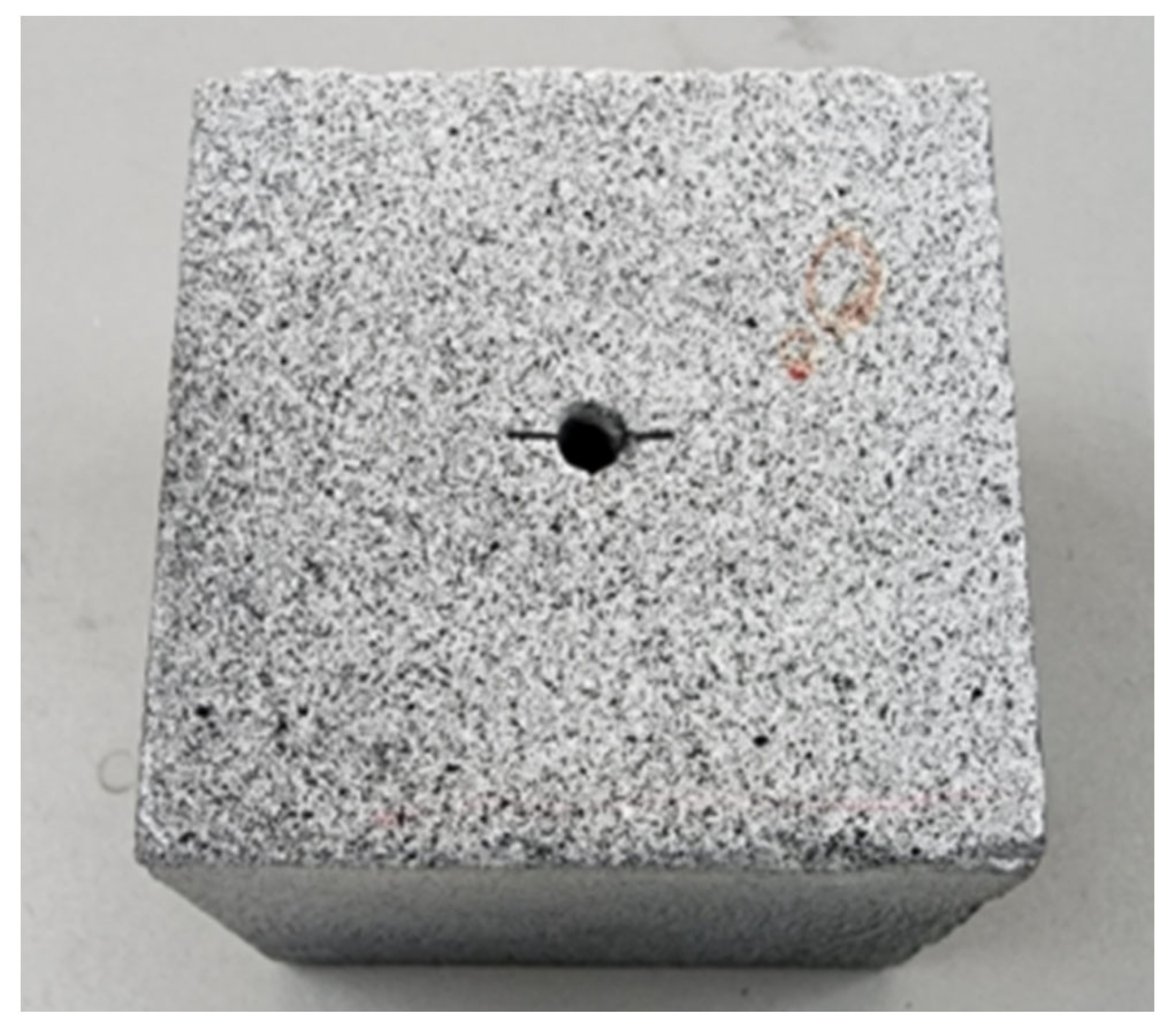
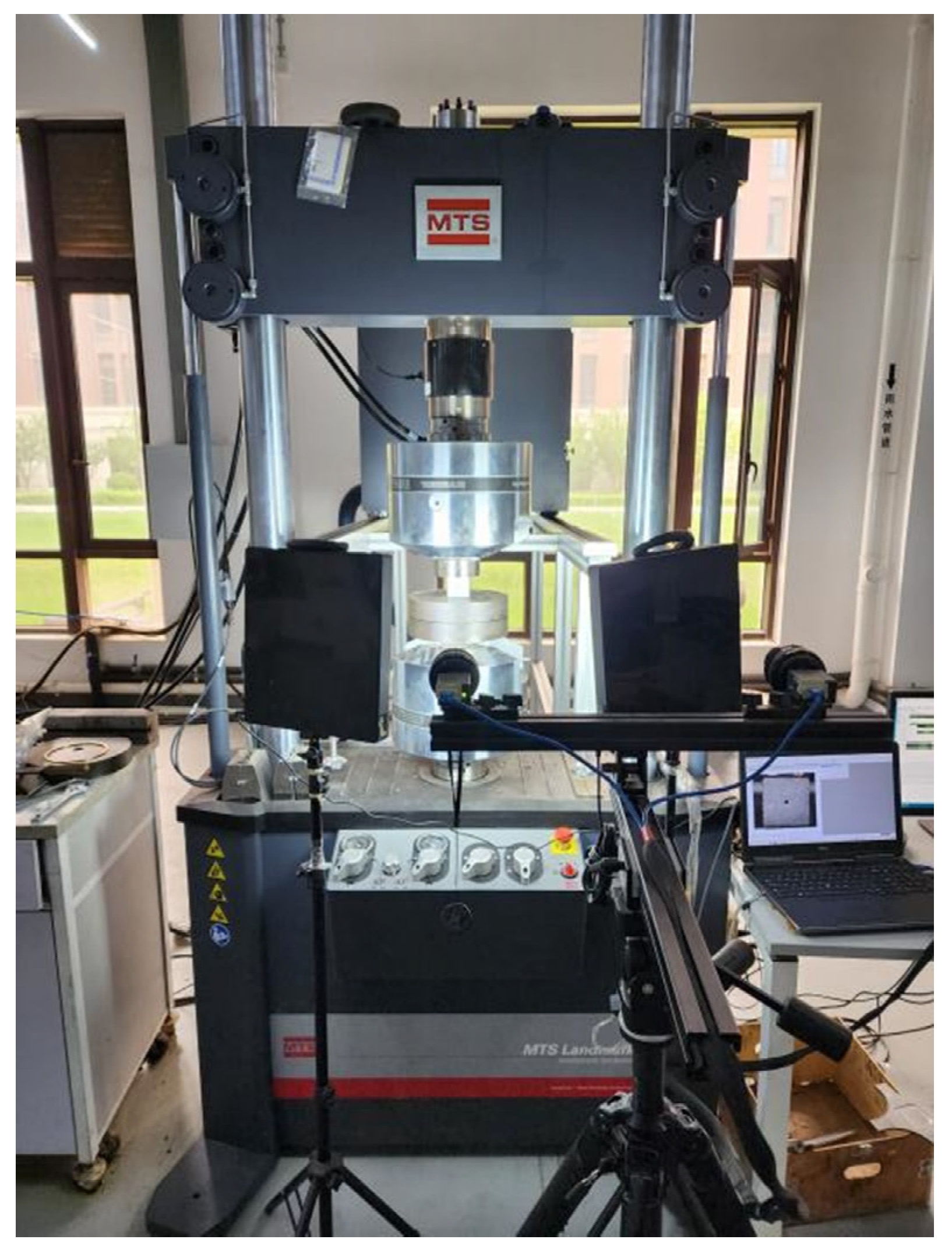
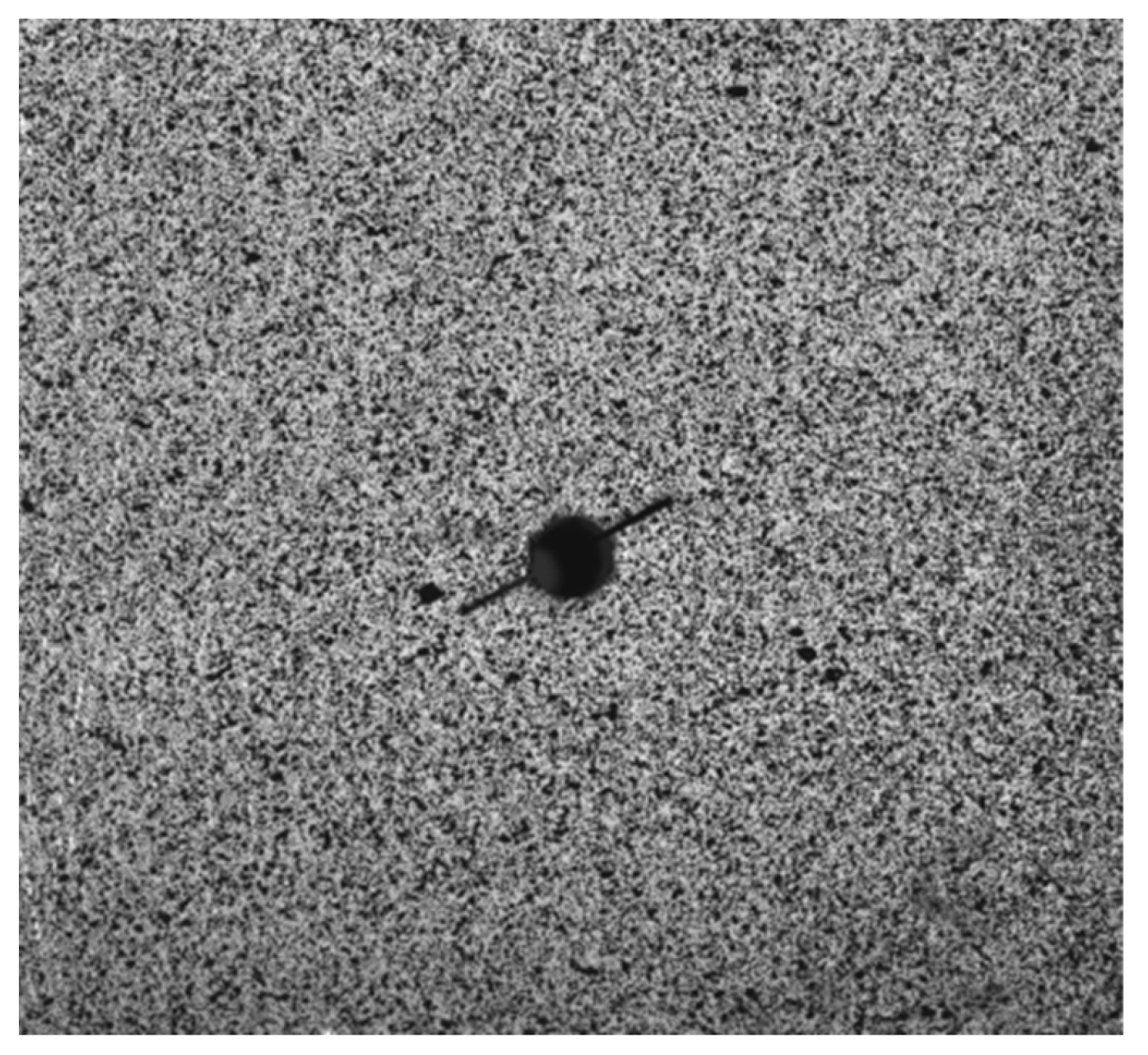
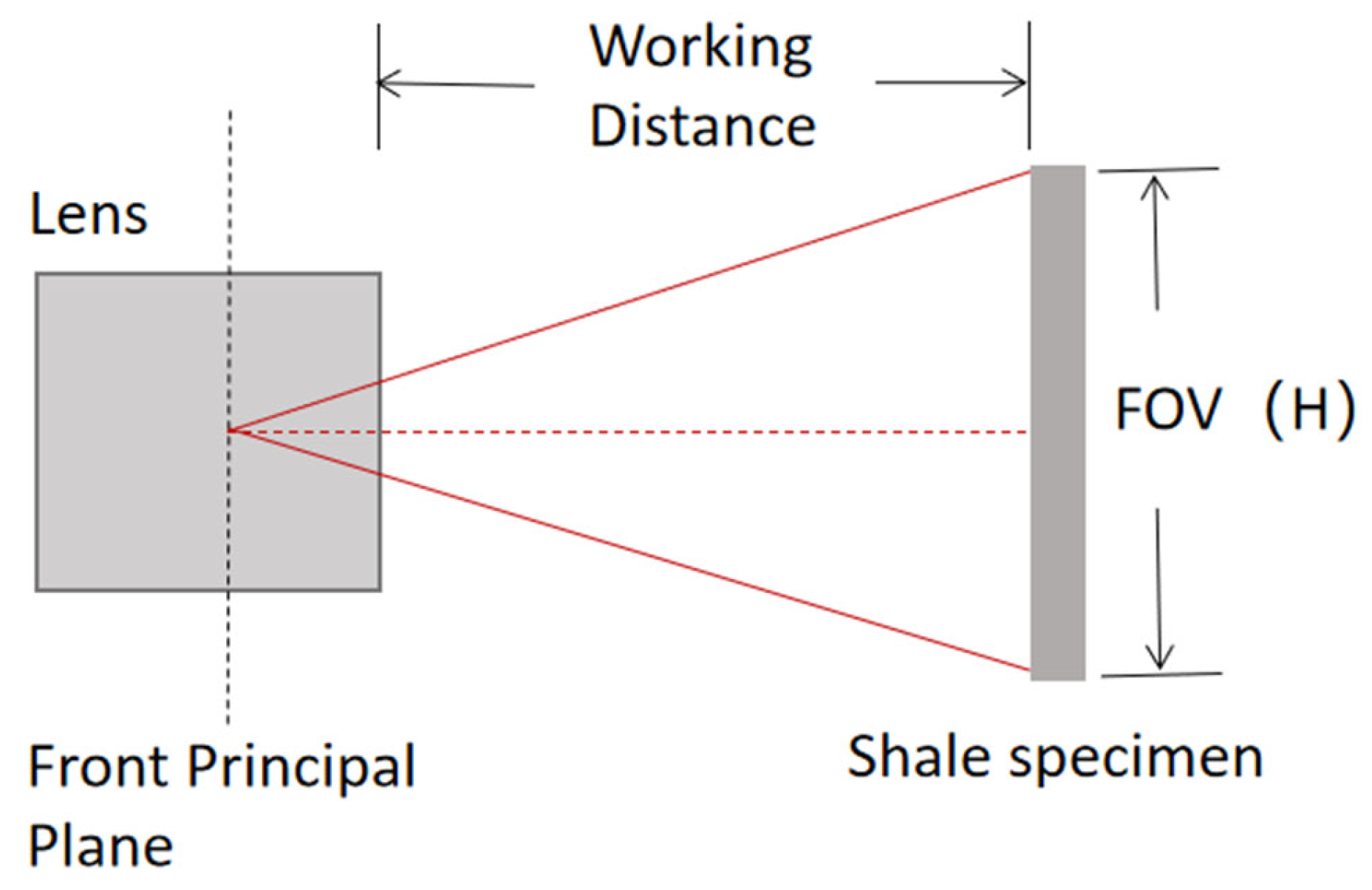

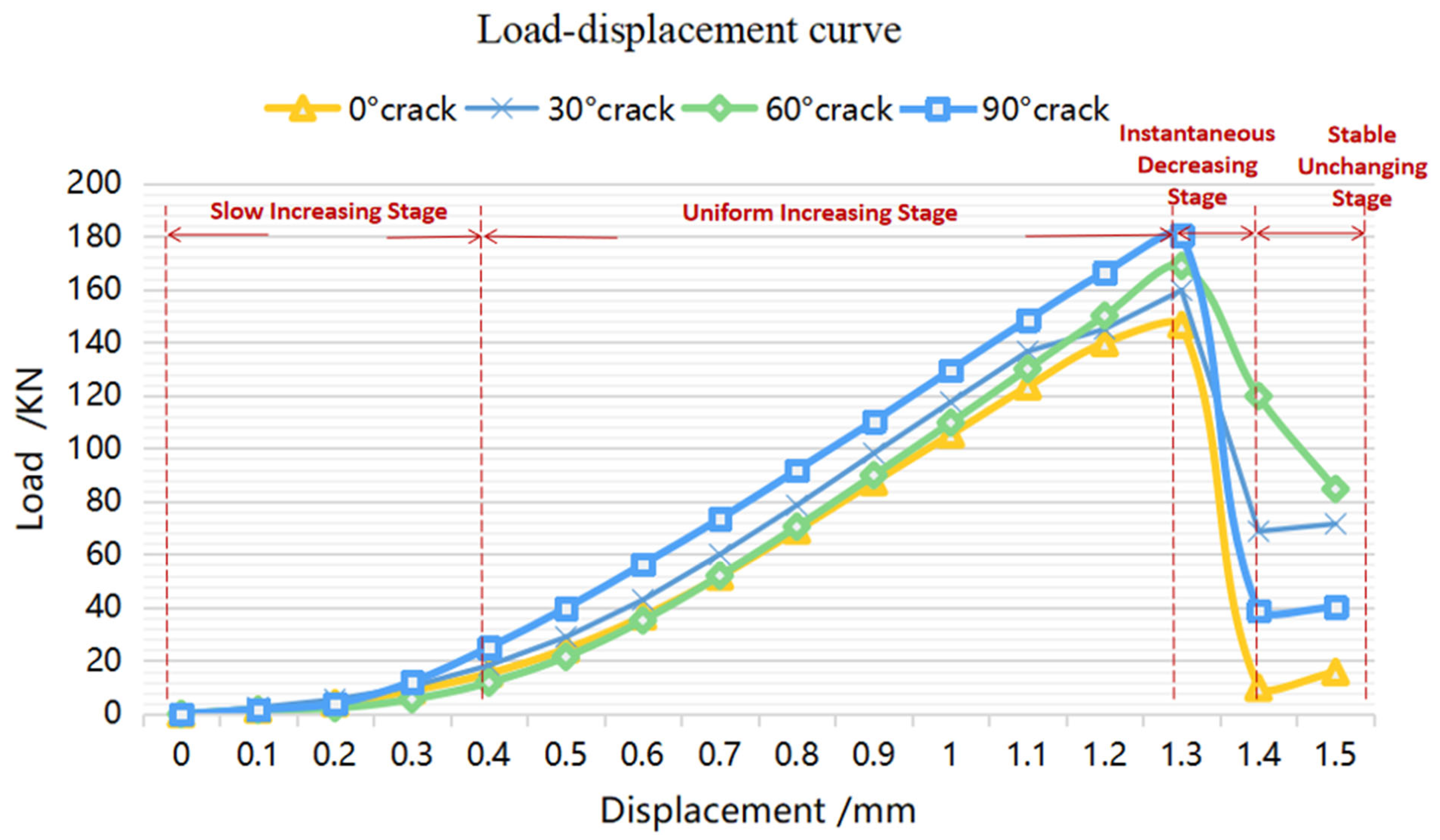
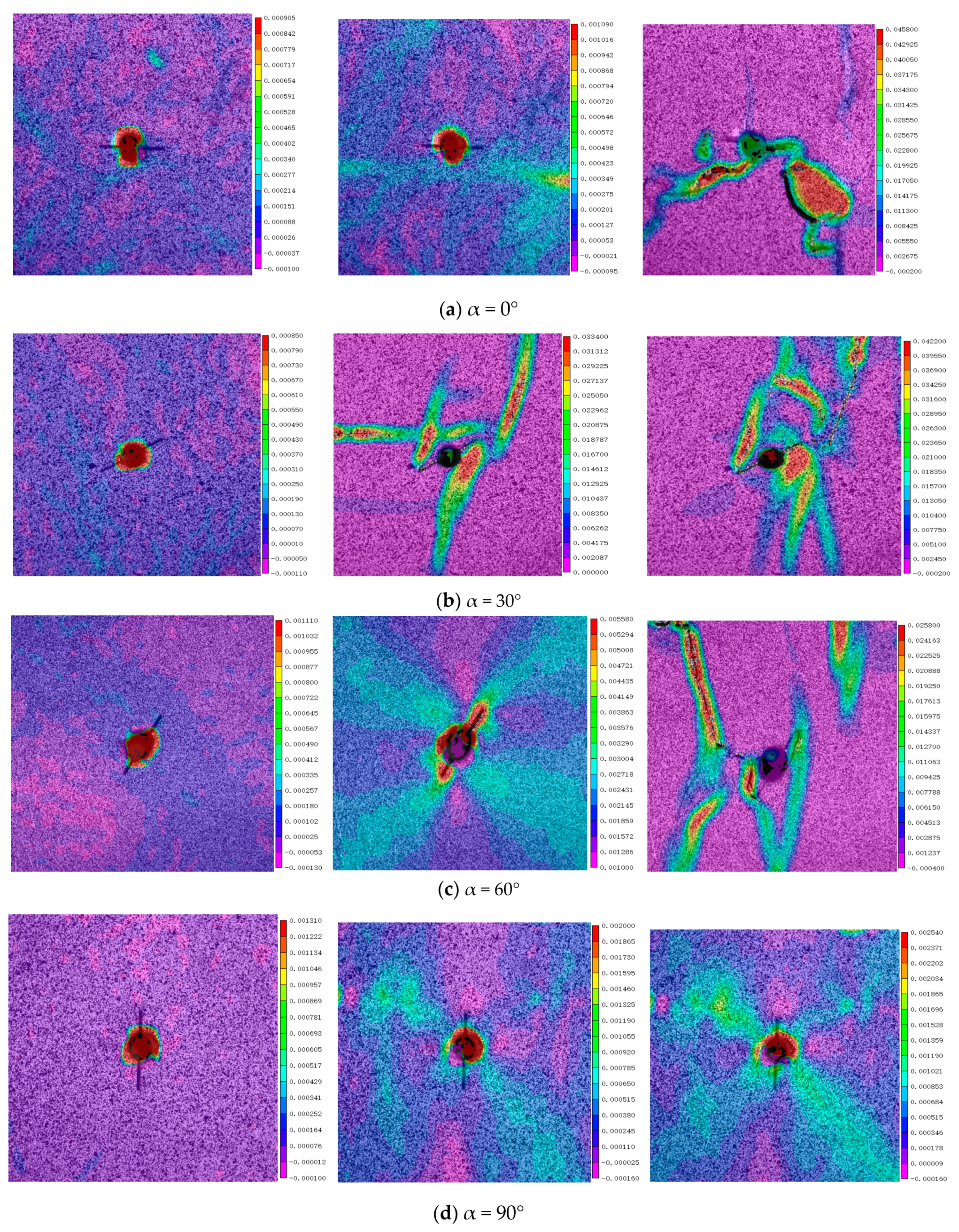
| Group Number | Rock Class | Specimen Shape | Fracture Length | Angle between Crack and Bedding Plane (α) | Number of Specimens |
|---|---|---|---|---|---|
| A | Shale | Cube (d = 50 mm) | 10 mm | 0° | 3 |
| B | Shale | Cube (d = 50 mm) | 10 mm | 30° | 3 |
| C | Shale | Cube (d = 50 mm) | 10 mm | 60° | 3 |
| D | Shale | Cube (d = 50 mm) | 10 mm | 90° | 3 |
Disclaimer/Publisher’s Note: The statements, opinions and data contained in all publications are solely those of the individual author(s) and contributor(s) and not of MDPI and/or the editor(s). MDPI and/or the editor(s) disclaim responsibility for any injury to people or property resulting from any ideas, methods, instructions or products referred to in the content. |
© 2023 by the authors. Licensee MDPI, Basel, Switzerland. This article is an open access article distributed under the terms and conditions of the Creative Commons Attribution (CC BY) license (https://creativecommons.org/licenses/by/4.0/).
Share and Cite
Liu, W.; Qu, Z. Strain Field Evolution Analysis of Brittle Shale with Initial Fractures Based on DIC. Processes 2023, 11, 2319. https://doi.org/10.3390/pr11082319
Liu W, Qu Z. Strain Field Evolution Analysis of Brittle Shale with Initial Fractures Based on DIC. Processes. 2023; 11(8):2319. https://doi.org/10.3390/pr11082319
Chicago/Turabian StyleLiu, Weihang, and Zhan Qu. 2023. "Strain Field Evolution Analysis of Brittle Shale with Initial Fractures Based on DIC" Processes 11, no. 8: 2319. https://doi.org/10.3390/pr11082319




